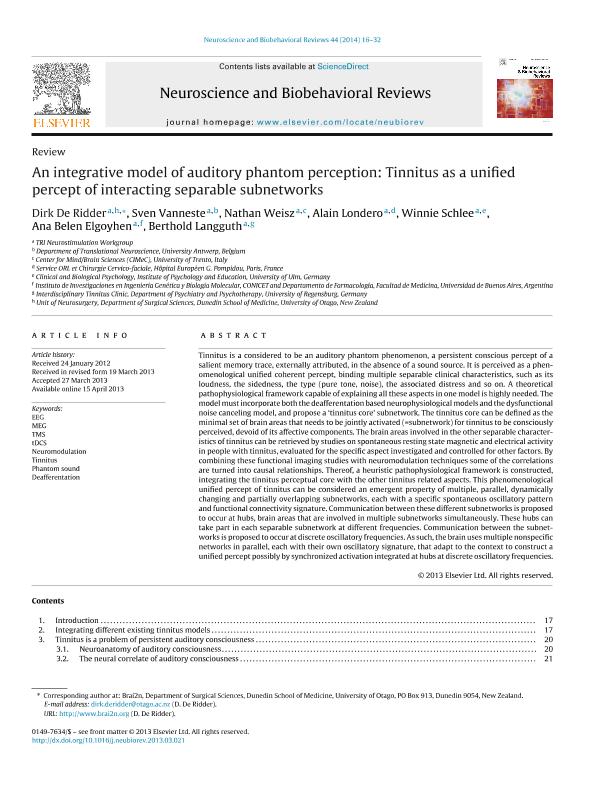Artículo
An integrative model of auditory phantom perception: tinnitus as a unified percept of interacting separable subnetworks
de Ridder, Dirk; Vanneste, Sven; Weisz, Nathan; Londero, Alain; Schlee, Winnie; Elgoyhen, Ana Belen ; Langguth, Berthold
; Langguth, Berthold
 ; Langguth, Berthold
; Langguth, Berthold
Fecha de publicación:
15/04/2013
Editorial:
Elsevier
Revista:
Neuroscience and Biobehavioral Reviews
ISSN:
0149-7634
Idioma:
Inglés
Tipo de recurso:
Artículo publicado
Clasificación temática:
Resumen
Tinnitus is a considered to be an auditory phantom phenomenon, a persistent conscious percept of a salient memory trace, externally attributed, in the absence of a sound source. It is perceived as a phenomenological unified coherent percept, binding multiple separable clinical characteristics, such as its loudness, the sidedness, the type (pure tone, noise), the associated distress and so on. A theoretical pathophysiological framework capable of explaining all these aspects in one model is highly needed. The model must incorporate both the deafferentation based neurophysiological models and the dysfunctional noise canceling model, and propose a ‘tinnitus core’ subnetwork. The tinnitus core can be defined as the minimal set of brain areas that needs to be jointly activated (=subnetwork) for tinnitus to be consciously perceived, devoid of its affective components. The brain areas involved in the other separable characteristics of tinnitus can be retrieved by studies on spontaneous resting state magnetic and electrical activity in people with tinnitus, evaluated for the specific aspect investigated and controlled for other factors. By combining these functional imaging studies with neuromodulation techniques some of the correlations are turned into causal relationships. Thereof, a heuristic pathophysiological framework is constructed, integrating the tinnitus perceptual core with the other tinnitus related aspects. This phenomenological unified percept of tinnitus can be considered an emergent property of multiple, parallel, dynamically changing and partially overlapping subnetworks, each with a specific spontaneous oscillatory pattern and functional connectivity signature. Communication between these different subnetworks is proposed to occur at hubs, brain areas that are involved in multiple subnetworks simultaneously. These hubs can take part in each separable subnetwork at different frequencies. Communication between the subnetworks is proposed to occur at discrete oscillatory frequencies. As such, the brain uses multiple nonspecific networks in parallel, each with their own oscillatory signature, that adapt to the context to construct a unified percept possibly by synchronized activation integrated at hubs at discrete oscillatory frequencies.
Palabras clave:
Tinnitus
,
Phantom Percept
,
Phantom Sound
,
Eeg
,
Meg
,
Tms
,
Neuromodulation
,
Deafferentation
Archivos asociados
Licencia
Identificadores
Colecciones
Articulos(INGEBI)
Articulos de INST.DE INVEST.EN ING.GENETICA Y BIOL.MOLECULAR "DR. HECTOR N TORRES"
Articulos de INST.DE INVEST.EN ING.GENETICA Y BIOL.MOLECULAR "DR. HECTOR N TORRES"
Citación
de Ridder, Dirk; Vanneste, Sven; Weisz, Nathan; Londero, Alain; Schlee, Winnie; et al.; An integrative model of auditory phantom perception: tinnitus as a unified percept of interacting separable subnetworks; Elsevier; Neuroscience and Biobehavioral Reviews; 44; 15-4-2013; 16-32
Compartir
Altmétricas



